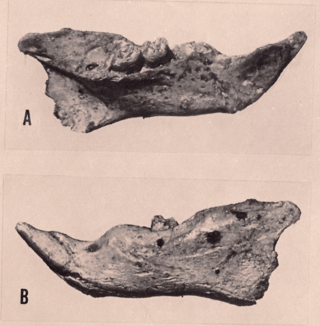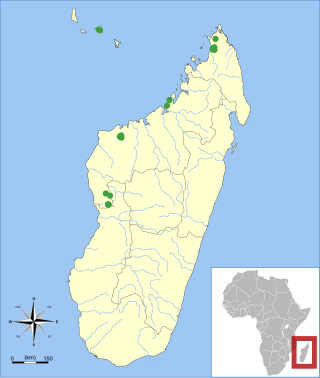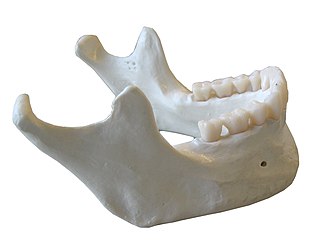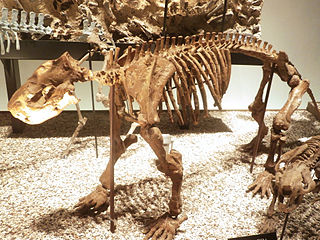
Catopsbaatar is a genus of multituberculate, an extinct order of rodent-like mammals. It lived in what is now Mongolia during the late Campanian age of the Late Cretaceous epoch, about 72 million years ago. The first fossils were collected in the early 1970s, and the animal was named as a new species of the genus Djadochtatherium in 1974, D. catopsaloides. The specific name refers to the animal's similarity to the genus Catopsalis. The species was moved to the genus Catopsalis in 1979, and received its own genus in 1994. Five skulls, one molar, and one skeleton with a skull are known; the last is the genus' most complete specimen. Catopsbaatar was a member of the family Djadochtatheriidae.

The Manavi long-fingered bat is a bat in the genus Miniopterus that occurs in east-central Madagascar. First described in 1906, this species was later included in the mainland African M. minor. A 1995 revision united populations of small Miniopterus from Madagascar and the Comoros as M. manavi, but molecular and morphological studies in 2008 and 2009 showed that this concept of M. manavi in fact included five different species. M. manavi itself was restricted to a few locations in the eastern Central Highlands and populations in the Comoros and northern and western Madagascar were allocated to different species.

Miniopterus, known as the bent-winged or long winged bats, is the sole genus of the family Miniopteridae. They are small flying insectivorous mammals, micro-bats of the order Chiroptera, with wings over twice the length of the body. The genus had been placed in its own subfamily among the vespertilionid bats, as Miniopterinae, but is now classified as its own family.
Gobicyon is an extinct genus of large-sized carnivoran mammals, belonging to the Amphicyonidae, that was discovered in China, Mongolia, and Serbia, and lived during the Middle Miocene epoch. Despite only being known from rather fragmentary remains, recent discoveries showcase that it was an aberrant member of the subfamily Haplocyoninae, with adaptions towards bone-crushing similar to those of a hyaena.

Megalomys audreyae, known as the Barbudan (?) muskrat or the Barbuda giant rice rat, is an extinct oryzomyine rodent from Barbuda in the Lesser Antilles. Described on the basis of a single mandible with the first molar missing and an isolated upper incisor, both of uncertain but Quaternary age, it is one of the smaller members of the genus Megalomys. Little is known about the animal, and its provenance and distinction from "Ekbletomys hypenemus", an even larger extinct oryzomyine that also occurred on Barbuda, have been called into question. The toothrow in the lower jaw has a length of 8.7 mm at the alveoli. The third molar is relatively narrow and both the second and third molars have a wide valley between their outer cusps.

Hipposideros besaoka is an extinct bat from Madagascar in the genus Hipposideros. It is known from numerous jaws and teeth, which were collected in a cave at Anjohibe in 1996 and described as a new species in 2007. The site where H. besaoka was found is at most 10,000 years old; other parts of the cave have yielded H. commersoni, a living species of Hipposideros from Madagascar, and some material that is distinct from both species. H. besaoka was larger than H. commersoni, making it the largest insectivorous bat of Madagascar, and had broader molars and a more robust lower jaw. As usual in Hipposideros, the second upper premolar is small and displaced from the toothrow, and the second lower premolar is large.

Triaenops goodmani is an extinct bat from Madagascar in the genus Triaenops. It is known from three lower jaws collected in a cave at Anjohibe in 1996, and described as a new species in 2007. The material is at most 10,000 years old. A bat humerus from the same site could not be identified as either T. goodmani or the living T. menamena. T. goodmani is identifiable as a member of Triaenops or the related genus Paratriaenops by a number of features of the teeth, such as the single-cusped, canine-like fourth premolar and the presence of a gap between the entoconid and hypoconulid cusps on the first two molars. T. goodmani is larger than the living species of Triaenops and Paratriaenops on Madagascar, and on the first molar the protoconid cusp is only slightly higher than the hypoconid, not much higher as in the other species.

Triaenops menamena is a bat in the genus Triaenops found on Madagascar, mainly in the drier regions. It was known as Triaenops rufus until 2009, when it was discovered that that name had been incorrectly applied to the species. Triaenops rufus is a synonym of Triaenops persicus, a Middle Eastern species closely related to T. menamena— the Malagasy species had previously been placed as a subspecies of T. persicus by some authors. Triaenops menamena is mostly found in forests, but also occurs in other habitats. It often roosts in large colonies and eats insects such as butterflies and moths. Because of its wide range, common occurrence, and tolerance of habitat degradation, it is not considered to be threatened.

Pipistrellus raceyi, also known as Racey's pipistrelle, is a bat from Madagascar, in the genus Pipistrellus. Although unidentified species of Pipistrellus had been previously reported from Madagascar since the 1990s, P. raceyi was not formally named until 2006. It is apparently most closely related to the Asian species P. endoi, P. paterculus, and P. abramus, and its ancestors probably reached Madagascar from Asia. P. raceyi has been recorded at four sites, two in the eastern and two in the western lowlands. In the east, it is found in open areas and has been found roosting in a building; in the west it occurs in dry forest. Because of uncertainties about its ecology, it is listed as "Data Deficient" on the IUCN Red List.

Miniopterus aelleni is a bat in the genus Miniopterus that occurs on Anjouan in the Comoros and in northern and western Madagascar.

Miniopterus brachytragos is a bat in the genus Miniopterus that occurs in northern and western Madagascar. Populations of this species have historically been included in Miniopterus manavi, but molecular data published in 2008 and 2009 indicate this supposed species in fact consists of five separate species, including the newly described M. brachytragos. Up to four species of this group may occur in the same place. M. brachytragos has been found in dry and wet forests from sea level to 320 m (1,050 ft) altitude.

Miniopterus mahafaliensis is a bat in the genus Miniopterus that occurs in southwestern Madagascar. Populations of this species have historically been included in Miniopterus manavi, but molecular data published in 2008 and 2009 indicate that this supposed species in fact consists of five separate species, including the newly described M. mahafaliensis. The species has been found in dry, spiny, and gallery forest, as well as more open habitats, in southwestern Madagascar.
Miniopterus zapfei is a fossil bat in the genus Miniopterus from the middle Miocene of France. First described in 2002, it is known only from the site of La Grive M, where it occurs with another fossil Miniopterus species, the smaller and more common Miniopterus fossilis. M. zapfei is known from five mandibles and an isolated fourth upper premolar (P4). The fourth lower premolar is more slender than in M. fossilis and the cingulum shelf surrounding the P4 is less well-developed than in living Miniopterus. The length of the first lower molar is 1.57 to 1.60 mm.
Lagrivea is a fossil genus of squirrel from the Middle Miocene of France. The single species, L. vireti, is known from three mandibles and two isolated teeth. All come from the fissure filling of La Grive L5, part of the La Grive-Saint-Alban complex in Saint-Alban-de-Roche, southeastern France. Lagrivea was a large tree squirrel with flat lower incisors and a large, triangular fourth lower premolar (p4). Each of the four cheekteeth bears a deep basin in the middle of the crown. The m3 is about rectangular in shape, but rounded at the back. Although m1 and m2 have two roots, m3 has three.

In jawed vertebrates, the mandible, lower jaw, or jawbone is a bone that makes up the lower – and typically more mobile – component of the mouth.

Bemalambdidae is an extinct family of pantodont mammals known from Early and Middle Paleocene of China.

Bemalambda is an extinct mammal, belonging to the pantodonts. It lived in the lower-middle Paleocene and the fossil remains have been found in China.
The Javanese long-fingered bat is a species of bat from the Miniopterus genus native to Indonesia. A common misconception was that Miniopterus blepotis belonged to the M. schreibersii subspecies. M. blepotis was recognized as a distinct species after the Schreibersii complex was divided. This is backed up by New Guinean mtDNA sequence data that is ascribed to M. blepotis. Whether it is a complex made up of multiple species is unknown.

Lonchocyon is an extinct genus of arctoid carnivorans, with possible affinities to amphicyonids or hemicyonine bears. It contains a single species, Lonchocyon qiui, known from a single left mandible discovered at the fossil-bearing locality Haerhada at the base of the Baron Sog Formation, which is located in Inner Mongolia, China, and dates to the late Eocene. This taxon is notable for its large size in comparison to other arctoid carnivorans of the Eocene epoch, and for its hypercarnivorous adaptions, most notably its large canine and strongly reduced premolars. The genus name is a combination of Greek lonch, meaning spear and referencing the spear-like paraconid on its lower carnassial, and cyon, meaning dog. The specific name honours Professor Zhan-Xiang Qiu.
Alagtsavbaatar is an extinct species of carnivorous cat-like carnivoran belonging to the superfamily Aeluroidea. It was endemic to Asia, with all known specimens being found in Mongolia, and lived during the late Eocene epoch. It is a monotypic genus, with the type and only known species being A. indigenus, and is named after the Alag Tsav locality where its remains were first discovered.













